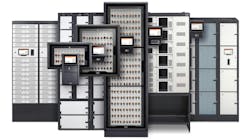Data Center Intelligence: Jason Waxman, CoolIT Systems
The Data Center Frontier Executive Roundtable features insights from industry executives with lengthy experience in the data center industry.
Here’s a look at the Q2 2025 insights from Jason Waxman, CEO of CoolIT Systems.
Jason Waxman, CoolIT Systems’ Chief Executive Officer, has over two decades of leadership in the data center and computing industry. He has a proven track record of driving innovation, operational excellence and global business growth. Before CoolIT, Jason held senior leadership roles at Intel Corporation, where he worked for over 23 years in the data center group and led large international teams. He spent 9+ years on the board of the Open Compute Project Foundation, whose mission is to enable scalable, sustainable computing. Just prior to CoolIT, Jason served as President of Fluke, a multi-billion dollar global testing equipment manufacturer. Jason is committed to developing a world-leading manufacturing operation, strengthening customer partnerships and accelerating innovation to support next-generation data center infrastructure.
AI Is Reshaping Infrastructure: How Are You Responding?
Data Center Frontier: How is your organization adapting to the infrastructure demands of AI? As artificial intelligence continues to redefine the design priorities for power, cooling, and site architecture, what specific innovations or strategic adaptations has your company implemented over the past year to meet the performance and deployment requirements of next-generation AI workloads?
Jason Waxman, CoolIT Systems: In addition to the sheer demand for AI infrastructure which appears insatiable, we are seeing a power requirements and densities that were unthinkable just a few years ago. AI GPUs now exceed 1,000 W thermal design power (TDP), and AI rack densities are being planned that would exceed 1MW. In contrast, just a few years ago, 200-300 W chips and 12 kW racks were considered high density.
CoolIT has responded to the extraordinary performance and market demands stemming from AI in two ways. First, we’ve worked with customers and partners to design liquid cooling solutions to meet their needs. Because the pace of change and innovation for customers has accelerated, we have invested significantly in engineering, rapid prototyping and design tools.
Second, we’ve dramatically ramped our production capacity to meet the massive demand for liquid cooling. Given the dynamic nature of the supply chain, our ability to scale manufacturing and support is as important as our continued product innovation. We are growing our production capacity in North America and Asia. We opened a new manufacturing site in Calgary, Canada, which increased our North American manufacturing capacity by 25 times. We’ve also strengthened our global supply chain, including pursuing dual-sourcing of critical components and supplier geographic diversification strategies.
Speed to Market Is a Competitive Edge: What’s Your Playbook?
Data Center Frontier: What strategies are helping you deliver infrastructure at speed without sacrificing resiliency? With timelines for data center delivery compressing across both hyperscale and edge environments, what proven approaches—whether in engineering, supply chain management, or partner collaboration—are enabling your organization to accelerate deployment while maintaining reliability, efficiency, and sustainability?
Jason Waxman, CoolIT Systems: When bringing a new product to market, we work closely with customers to define performance, reliability, and production requirements; then move fast.
For example, in our Liquid Lab™ Innovation centers in Calgary and Taipei, we rapidly design, prototype, test, and validate—as well as UL certify—new products all in-house. Our Liquid Labs allow us to compress development timelines without compromising quality or reliability. Every CoolIT product is engineered using Design-for-X principles that consider performance, reliability, quality, manufacturability and serviceability from day one. So, when a product has completed testing, validation and certification, we are ready for manufacturing ramp. This includes making sure the supply chain can support a product’s production scale-up as well as provide components that meet or exceed our quality standards.
We’re also increased industrial automation in our assembly processes, including robotics and AI-driven optical inspection systems, to ensure high-quality, high-volume output. Whether it's our own product or one custom-designed and produced for a customer, our rapid development capabilities combined with the ability to ramp manufacturing rapidly, ensure we can quickly bring new products to market at scale.
Standardization vs. Customization: What’s the Right Balance Now?
Data Center Frontier: How are you balancing standardization with client-specific customization in 2025? Given the dual pressures of rapid scaling and the unique demands of AI and hybrid workloads, how is your team navigating the trade-offs between delivering standardized infrastructure and meeting bespoke customer needs? Where do you see flexibility delivering the most value today?
Jason Waxman, CoolIT Systems: Balancing standardization and customization is no longer an either-or decision. Hyperscale datacenter design requires customization for efficiency. Each datacenter is designed around the customer value and application to be delivered, and the infrastructure is optimized to most efficiently deliver those workloads. What this means to us is that we need to build products that use common-off-the-shelf components but are designed for the unique customer requirements. To this end, we’ve developed a portfolio of modular, interoperable components that we can use to get a product to market quickly.
Take the development of a cooling loop for a customer’s new server SKU. We can move quickly into development because we’ve already worked with silicon manufacturers to develop coldplates that are fully optimized and validated for their next-generation processors. We leverage existing components where possible to improve supplier qualification and testing cycles. Well-defined test and validation processes provide clarity. An established supplier base and high-volume manufacturing capacity mean we can scale production.
About the Author
Matt Vincent
A B2B technology journalist and editor with more than two decades of experience, Matt Vincent is Editor in Chief of Data Center Frontier.



